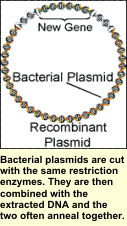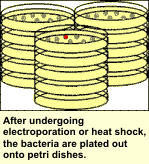Constructing a gene library requires not only the extracted DNA, but also restriction enzymes and a plasmid.
Step 1: DNA extracted from an organism, with the gene of interest, is cut into gene-size pieces with restriction enzymes. These enzymes read the nucleotide sequence of the DNA and recognize specific sequences. The enzymes then cut the DNA sequence by breaking the bonds between nucleotides in a DNA strand.
Step 2: Bacterial plasmids are cut with the same restriction enzyme. Plasmids are small circles of DNA in bacterial cells that are naturally present in addition to the bacteria's other DNA.
 Step 3: The gene-sized DNA and cut plasmids are combined into one test tube. Some of the enzyme cut DNA pieces will combine with the cut plasmids and form recombinant DNA (or DNA in a 'new combination').
Step 3: The gene-sized DNA and cut plasmids are combined into one test tube. Some of the enzyme cut DNA pieces will combine with the cut plasmids and form recombinant DNA (or DNA in a 'new combination').
Step 4: The recombinant plasmids are then transferred into bacteria using either electroporation or heat shock. Electroporation uses mild pulses of electricity to disrupt the cell walls of the bacterium and create small holes. The plasmids are small enough to pass through the holes into the cell. Heat shock works in a similar fashion. However, rather than using electricity to create holes in the bacterium, it is done by alternating the temperature between hot and cold.
Step 5: The bacteria is grown on a culture dish and allowed to grow into colonies. All the colonies on all the plates (cultures) are called a gene library.
Step 6: The gene library is then screened in order to discover which bacterial colony is making copies of the one gene they are interested in. Library screening identifies colonies, which have that particular gene. Screening can be based on detecting the DNA sequence of the cloned gene, detecting a protein that the gene encodes, or the use of linked DNA markers. Therefore before library screening can be done, the scientist must know either the DNA sequence of the gene, or a very similar gene, the protein that the gene produces, or a DNA marker that has been mapped very close to the gene. When the bacteria multiply and replicate the recombinant DNA, the number of gene copies also increases, making gene or protein detection easier.
 When the bacteria colony containing the desired gene is located, the bacteria can be propagated to make millions of copies of the recombinant plasmid that contains the gene.
When the bacteria colony containing the desired gene is located, the bacteria can be propagated to make millions of copies of the recombinant plasmid that contains the gene.
The plasmids can be extracted for the next steps of genetic engineering, gene modification, and transformation. Gene cloning is also important because copies of a gene are needed for these procedures.









